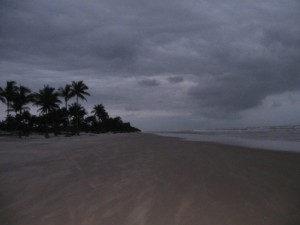
Photo © Michael Sommers.
A small, but crucial part of every travel writer’s fundamental duties is providing a response to the oft-posed question: “When to Go?”I can’t speak for my colleagues, but from my own experience writing about Brazil, “When to Go?” used to be one of the easier questions tossed my way. Though lacking a background in meteorology or climatology, I used to feel fairly sure in my predictions as to what kind of weather my readers would likely encounter in a given region, at a given time of year. This is because, traditionally, much of Brazil possessed very stable and distinctive weather systems.
Recently, however, all bets are off.
Early this week, in the company of my frequent traveling companion Annie (aka my sister), I left my adopted hometown of Salvador heading south along the coast of Bahia. I’ve lived in Bahia for 13 years and know its tropical seasons well…
March, April, and May are characterized by torrential rains that herald the end of the summer and last for hours or days on end.
June, July, and August are marked by cold fronts that sweep up from Argentina, bringing dark clouds, cool winds and drizzle or downpours that last for 1-3 days.
The rest of the year delivers sun, sun, and more sun (with the occasional 5-10-minute tropical cloudburst). It was precisely with the “sun, sun, and more sun” in mind that I planned our trip to the south of Bahia for the pre-summer period of late October/beginning of November.
Having carefully adhered to this climatological calendar, how is that when we awakened on the first morning of our journey, and tore open the curtains masking the panoramic view of alluring Tiririca Beach, in Itacaré, we were greeted by ominous grey clouds shrouding the entire sky?
Moreover, how come, just as we were digging into our delicious morning tapioca (a Northeast version of a crepe made of crunchy manioc flour), did it begin to rain?
And how come the rain, gunmetal grey skies, and wind that howled as if as if it were a sound effect in a Wuthering Heights remake didn’t stop throughout the entire day?
Nor the day after that…
Nor the days after…
Oh, there were brief, tantalizing slivers of blue.
There were even a couple of 20-30 minute teasers when a lemony ball of noon heat pressed against the clouds, creating faint shadows when we raised our hands above our naked bellies, and cruelly tricking us into slathering sun protector all over our desperately prone bodies.
However, no sooner had we began lolling beneath the ultraviolet rays when the clouds resumed their oppressive shades of grey and winds sent us diving deep into our knapsacks for hoodies.
Although we try to soak up the otherwise relaxing surroundings, a certain angst takes hold as we surreptitiously scan the sky, trying to read the clouds, constantly searching for signs.
What’s with this weather in October? “Cold front up from Rio de Janeiro.”
How long is it going to last? “Probably all day.”; “At least today—and maybe tomorrow.”; “For five days.”; “Until next week.”
Why is this happening? “Global warming.”; “God works in mysterious ways.”; “This is karmic payback—I tempted Fate by packing too many warm clothes just in case” (this last from my superstitious sister Annie).
Wherever we go, whomever we meet, the state of the sky inevitably becomes the prime conversational ice breaker.
There are those who:
— tell us how exceptional this weather is (which makes us feel: 1. better that our original plans weren’t stupidly laid and 2. worse because why has Mother Nature singled us out?)
— give us play-by-play, hour-by-hour weather updates—and then regale us with reassuring tales of how often past weather forecasts have been completely wrong (no such luck this time).
— encouragingly indicate a sudden square inch of almost blue in a peripheral portion of sky and say that this “janela aberta de azul” (open window of blue) is a sign of clear skies to come.
— gaze discouragingly at the other 99 percent of the cloud covered sky, shake their heads, and mincing no words, tell us that things don’t look good.
— express sympathy for our plight (which makes us feel like superficial whiners—just how important is a sunny beach in the global scheme of things?)
— confess to feeling guilty (mostly hotel owners/employees), as if they were somehow responsible for offering their guests perfect weather along with clean sheets and plumped pillows.
— cheerily announce that the sun won’t appear for another 5 or 6 days—then ask if we’d like some more coconut water or passion fruit juice.
— advise us not to lose hope and to pray to São Pedro (patron saint of matters related to rain)—advice that we’ve taken…
In the meantime, each morning we awaken with an increasingly acute mixture of dread and hope as we muster up courage to open the blinds and see what the skies hold in store for us.
On the upside, we’ve managed to transform breakfast into a leisurely 2-hour affair, we’ve caught up on Brazilian society gossip going back to the 1990s (via old magazines), and we’ll have enough leftover sun block to last us for a couple of years.
As Carlos, a curly-headed surfing instructor from Itacaré confessed, the weather in Bahia used to function like a finely-tuned máquina (machine). For whatever reason, the maquina is breaking down.
All this is to say that the next time you plan a trip to Brazil based on one of those “When to Go” indications, take the precaution of packing an umbrella, a couple of sweaters, and plenty of extra reading material.